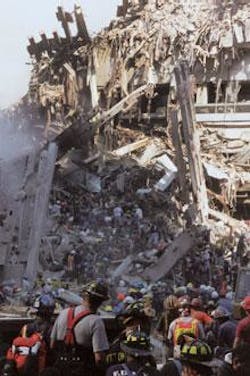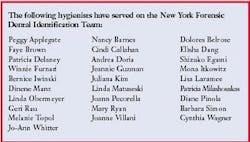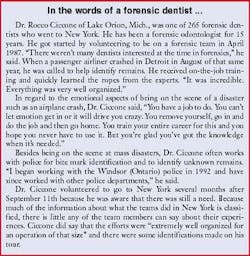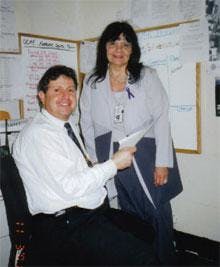The Daily Reminder of September 11
by Cathleen Terhune Alty, RDH
It's hard to believe the events of 9/11 are now two years in the past. The memories of what happened are still so fresh. As with most major tragedies, we distinctly remember where we were and what we were doing the day the towers burned and fell. We remember being riveted to the news, suspended between disbelief and horror that this could happen in our country. Of the people who were immediately put into action, a forensic team of dental professionals were called to help coordinate and identify the remains of those who perished in the rubble. Several dental hygienists were included as a part of the forensic team. On this, the second anniversary of the WTC attacks, one dental hygienist is still serving on the Dental Identification Team at the Office of the Chief Medical Examiner in New York City.
Winnie Furnari, RDH, BS, still spends one day a week in the volunteer effort to identify remains of victims. Winnie has been a member of the Dental Identification Team for 14 years and has served on the team for other mass disasters. As a member of the New York Society of Forensic Dentistry, she and other hygienists attend the meetings and continuing education courses year round to be prepared. One can never be as prepared as you might think for what occurred on September 11, 2001.
The Mass Disaster team was activated again on September 11, 2001 and Winnie was there to serve. She says, "This was the largest offering of dental help for any one single volunteer effort."
A total of 28 hygienists from New York, New Jersey, and Connecticut came to help during the peak times. Many volunteers came from the membership of the society, yet many came from the enormous number of phone calls and faxes from across the country and Canada. The chief forensic dentist, Dr. Jeffrey Burkes, assigned her to be the dental staff coordinator, but that is only a small part of what she and the other hygienists on the team did in the effort.
The model for the team consists of sections: the "Go" section, ante mortem section, postmortem, and comparison. These are all laid out with specific protocols for each responsibility. Go Team members actually go on site to help make sure dental evidence is secured. These are the trained, experienced and authorized forensic dentists.
Apart from the Go Team, hygienists were involved in every other section for the WTC disaster.
In the ante mortem section, they helped secure dental records of victims and interpret them. They helped make charts by collecting, recording, and filing data and entered them into a computer program, WIN ID, created solely for making dental identifications. There were times they were working with dentists, insurance companies, and consulates.
In the post mortem section, several of the hygienists helped with post mortem exams. They charted, radiographed, and mounted X-rays, and also helped enter them into the computer program. They cleaned instruments, changed solutions, and stocked supplies.
In the comparison section, the hygienists also worked hard trying to make matches. They spent time here making computer entries and maintained charts. Whenever a potential match was made not one but two authorized forensic dentists had to review it and sign off on the ID. This is a daunting responsibility.
Another one of the major responsibilities the hygienists worked with was the scheduling of the volunteers. There were 24-hour shifts and it was a monumental job getting people and their needs to work out. They checked credentials on anyone working at the morgue and did memos, filing, and answered the non-stop ringing of several phones and faxes.
Thousands of hours were clocked in for the hygienists. Winnie has close to 2,000. They did overnights and spent every day off and weekends in New York City.
Winnie was responsible for keeping track of who was there, when, and how many hours each volunteer contributed. Though no one contribution was more important than another, the dental hygienists were responsible for the organization and management of the operation.
They were vital and most versatile, serving in each and every aspect. Many of them went from answering phones, making calls, scheduling, credentialing, writing memos, making hotel accommodations, keeping sign-in sheets, rules, regulations and protocols, procuring office supplies, copying, faxing, and maintaining databases for compiling reports.
They came and they gave. Together, they found strength beyond themselves. They came and they gave in the spirit of helping their fellow man. As a result, this Dental ID Team, forged in loss, transformed into a family of over 300 volunteers.
The team never lost sight of why they were there — to positively identify remains.
Winnie said the team fulfills its mission when they are able to make identifications and send a victim home to the family. When asked how she feels to be able to make such a difference Winnie answers, "Privileged."
She has become a member of the American Society of Forensic Odontology and speaks with fellow team members to dentists at continuing education courses and conferences.
She is now pursuing her education in bioterrorism preparedness. She attended the Bioterrorism Conference in Washington, D.C., earlier this year and took the U.S. Army training course (CBRNE), and she is helping out with the New York University Preparedness Committee. She is also making liaison commitments to the New York State Dental Society's bioterrorism preparedness committee so that dentists and hygienists will continue to work together in times of catastrophe.
Winnie is past president of Dental Hygienists' Association of the State of New York, serves on the association's board of directors, and is head delegate to ADHA from New York. She is president of Mid-Hudson Dental Hygienists' Association, is in clinical practice, is a part-time faculty member at NYU, and serves on the advisory boards of two dental hygiene programs.
Winnie is a member of the American Academy of Dental Hygiene and several forensic organizations. She teaches a course titled, "Forensic Dentistry and the Role of the Dental Hygienist."
The team has been recognized by many associations and governmental agencies, and rightly so. The ADHA has recently adopted a policy to support the utilization of dental hygienists in events of bioterrorism and catastrophe due to Winnie's efforts.
Winnie hopes to get more hygienists involved with forensic dentistry and is working on projects to get information out to others across the country. She gets several e-mails a week from hygienists and students wanting to participate and will try to help all she can.
Winnie can be contacted at [email protected].
Cathleen Terhune Alty, RDH, is a frequent contributor. She is based in Clarkston, Mich.





